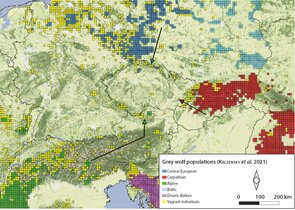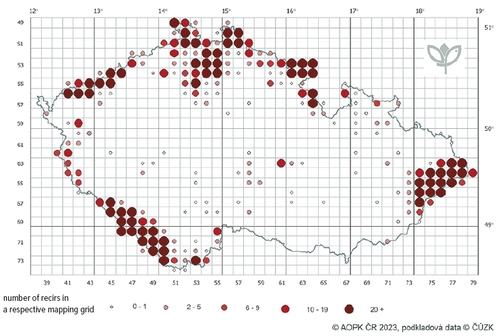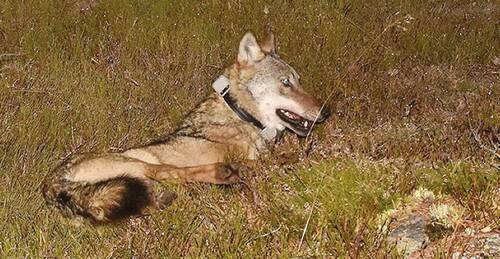Nature Conservation 2024 — 30. 5. 2024 — Research, Surveys and Data Management — Print article in pdf
On the Origin of Czech Wolves Using the Slavkovský les/Slavkov Forest Mts. As an Example

Despite the considerable effort of scientists and conservationists to clarify all aspects of the biology of the Grey wolf (Canis lupus) and its expansion in Central Europe, various misconceptions and mistakes live on with the general public, which may lead to needless conflicts. The purpose of this contribution is to clarify the origin of Czech wolves in the light of the return of wolves to Central Europe, using the example of an area with a rich hunting tradition and of extraordinary importance from the point of view of nature conservation.
Top predators have always aroused various emotions among people, from hatred to admiration and respect. The reasons for such emotions are equally diverse, from an exaggerated perception of their potential danger to people and human livelihood through admiration of their hunting skills to a rational awareness of the hardly replaceable role of predators in natural processes. The Grey wolf has always been one of the most conflicting species. This is perhaps because among the European top predators it has the strongest ability to adapt to human-managed landscapes and to reoccupy areas in which it has historically been exterminated (Chapron et al. 2014).

Grey wolves captured by a camera trap in the central forests of the Slavkovský les/Slavkov Forest Mts., 10 May 2023 © Pavel Jaška
Some history
The wolf used to inhabit probably all of Europe. At least since the Last Ice Age, however, its expansion has been influenced by the presence of man. In addition to a transformation of the environment, that was mainly caused by its persecution of various intensity. In the last two centuries, the species disappeared from most of Central and Western Europe, and the remaining populations became isolated each other (Pilot et al. 2014). In the Czech Republic, wolves used to be relatively common until the late 17th century. Intensive persecution led however to its practical extermination by the early 20th century (Červený et al. 2005, Bufka et al. 2005, Matějů 2010).
In the 1950s and 1960s, Central Europe was still almost free of wolves. Just over a hundred individuals of the Carpathian population, with its centre in the Romanian mountains, was surviving in Slovakia. The Carpathian population also reached the ridges of the Tatra Mountains (dozens of them) in eastern Poland. There was further a Baltic population (individuals only) with its core in the Baltic states, and perhaps partially a Pontic population from the Ukrainian steppes. The Dinaric-Balkan population reached southern Slovenia through the former Yugoslavia. Roughly another hundred wolves were surviving in the Italian Apennines. In Western Europe, wolves (hundreds of them) only lived on the Iberian Peninsula. To complete the picture, Finnish wolves balancing on the brink of extinction should be mentioned. Wolves were thus absent from e.g. France, Germany, Switzerland, Austria, Hungary, Norway, and last but not least, the Czech Republic (Chapron et al. l.c.).
|
Box 1: Genetic monitoring
Yearly hundreds of wolf samples are genetically processed supported by the Nature Conservation Agency of the Czech Republic (https://www.navratvlku.cz/o-vlkovi-genetika/). Thanks to comparison with other European countries in collaboration with the CEwolf Consortium (e.g. Szewczyk et al. 2019, 2021) and under other projects (Vorel & Blättler 2018), we are able to provide at least partial information on the genetic affiliation of each newly monitored wolf. The sample of the five wolves from the Slavkovský les/ Slavkov Forest Mts. have become part of this research effort. |
Return to Central Europe
Since the end of the 20th century, however, a reversal on the continental level has been observed. The European wolf population has been stabilising or growing (Chapron et al. l.c.). We are witnesses of a recolonisation of large areas. After the introduction of wolf protection in Italy, the Apennine population has started to grow and expand. In the early 1990s it had reached the southeast of France and the Swiss Alps (Valière et al. 2003). Wolves spread across France from there, e.g. to the Pyrenees, the Massif Central and the Vosges west of the Rhine. In the Italian Alps, the population increased from the first Alpine pack at the Italian-French border in 1996–1997 to a total of 293 wolves in approximately 51 packs/pairs in 2017–2018. The population of Slovenian wolves from the Dinaric-Balkan population is also growing (summarised on web1). After strict protection of wolves was introduced in Poland in 1998, also the Baltic population has expanded to a point that it could cross the Wisla/Vistula River. First, wolves reproduced on the German side of the Saxon-Polish border in 2000. The western Polish population clearly started to be established in 2004. In 2013-2014, already around 140 wolves in roughly 25 packs and several separate pairs have lived there (Novak & Myslajek 2016). Wolves further spread over Germany, particularly along the Labe/Elbe River in north-western direction (Jarausch et al. 2021). In 2013–2014, a number of 25 packs and another eight pairs were registered there (Reinhardt et al. 2015), in 2020-2021 already 157 packs and another 27 pairs (web2).
Wolf expansion usually takes place in several steps. First, individuals wandering through the countryside appear, looking for partners. In the second stage, individuals settle, make pairs, and a pack is formed only if the environmental conditions are appropriate (Mech 1970). In the Czech Republic, the number of wolf records has slowly grown since the 1970s. Since the 1990s, following the expansion of the Carpathian population, wolves live marginally in the Moravskoslezské Beskydy/Moravian-Silesian Beskyd Mts. on the Czech-Slovak border (Červený et al. 2005), from where they sometimes penetrate into the Jeseníky Mts. and Bílé Karpaty/White Carpathians Mts., but also elsewhere (Anděra & Horáček 2019). Genetic analyses have confirmed that our Moravian-Silesian wolves originate from the Carpathian population (Hulva et al. 2017). The lowland Central European population from the Saxon-Polish border region has been settling in Bohemia since 2011. The wolves probably first appeared in the Šluknov Spur and around the town of Ralsko at the border with Germany. In 2018, they were also observed in the Broumov region, the Krkonoše/Giant Mts., the Šumava/Bohemian Forest Mts. range, the Orlické hory/Eagle Mts., Krušné hory/Ore Mts., and Novohradské hory/Freiwald Mountains, apparently also in the Doupov hory/Doupov Hills, and further in České Švýcarsko/Bohemian Switzerland, the Český les/Upper Palatine Forest and in the Třeboň region (web3). Such rapid colonisation after the first packs have settled is typical of wolf expansion and corresponds to the situation in Italy, Poland, and Germany (Valière et al. l.c., Novak & Myslajek l.c., Jarausch et al. l.c.).
The hitherto published results of genetic analyses of Czech wolves thus primarily point to their origin in the Baltic population (across Poland and eastern Germany) with an overlap of the Carpathian population in the Czech-Slovak borderland. The majority of Czech wolves therefore are an integral unit with the German and west Polish wolves (Hulva et al. l.c., Szewczyk et al. 2019, 2021). Marginally however, admixture of individuals from other populations cannot be ruled out (e.g. Hulva 2019).

Occurrence of the Eurasian wolf (Canis lupus) in the Czech Republic in 2000–2023
© Nature Conservation Agency of the Czech Republic 2023

Female wolf from a pack-founding pair in the Slavkovský les/Slavkov Forest Mts. after being equipped with a telemetric collar in the Šumava/Bohemina Forest Mts. at the end of 2021 © Aleš Vorel
View from the Slavkovský les/Slavkov Forest Mts. region
The Slavkovský les/Slavkov Forest Mountains, infiltration zone of the famous West Bohemian spas, do certainly not offer only the therapeutic prominence of the spa sector. It is an area of long-term close contact between nature conservation, hunting traditions, and forestry. The Slavkovský les/Slavkov Forest Mts. Protected Landscape Area (PLA) was declared there in 1974. In 2012, its most valuable forest and non-forest wetlands were included among Wetlands of International Importance, thus becoming Ramsar Site (Tájek 2012). And finally in 2020, Kladská was declared a Landscape Heritage Zone, which includes the most valuable forest ecosystems and peat-bogs around the settlement of Kladská. Its protection mainly consists in maintaining the cultural landscape including a preserved hunting area with an unbroken tradition since the 1870s. In the days of its fame, the hunting area was one of the most important in the whole of Europe (Adamec 2021). Hunting traditions and nature conservation are therefore of fundamental importance. For the past couple of years, various credible reports about wolf movement in the Slavkovský les/Slavkov Forest Mts. have appeared. At the end of 2022, information about the presence of a pack emerged more often. This was confirmed by the Nature Conservation Agency of the Czech Republic (NCA CR) staff at the turn of September and October 2022 thanks to a camera trap and various signs (Jaška et al. 2022). The wolves’ arrival there raises just as somewhere else various emotions across nature conservationists, foresters, gamekeepers/hunters as well as the general public
Results of genetic monitoring
Since October 2022, the wolves of the Slavkovský les/ Slavkov Forest Mts. have been monitored intensively by the NCA CR’s, namely the Slavkovský les/Slavkov Forest Mts. PLA Regional Branch, in collaboration with the Czech University of Life Sciences Prague and Charles University Prague. The monitoring is carried out by camera traps, registration of credible observations, and the monitoring of signs, including killed and ripped wild and domestic animals. An integral part of the field work is the collection of samples for subsequent genetic analyses, which were first financed under the OWAD (Objective Acceptance of the Wolf in a Human-Transboundary Landscape) project (Interreg Czechia – Saxony, 2016–2020m funded from the European Union’s funds). Currently the analyses are financed by the NCA CR as part of the Grey Wolf Management Plan under the National Restoration Plan – Programme for the Restoration of Natural Landscape Functions.
In the Slavkovský les/Slavkov Forest Mts., six faecal samples from five wolves have been successfully analysed to date. An interesting result was the identification of a female wolf wearing a telemetry collar, which turned out to be an animal from the Šumava/Bohemian Forest Mts. range, whose pedigree goes back to the Alpine population. This was explained by a male from the Alps being involved in the formation of the first Šumava/Bohemian Forest Mts. pack. He mated in the Šumava/Bohemian Forest Mts. with a female from the Central European lowland population and established a pack there. In 2021, a granddaughter of the wolf from the Alpine population was captured in the Šumava/Bohemian Forest Mts. DNA samples were taken from it, and a telemetry collar was attached to it. Subsequently, it moved to the Slavkovský les/Slavkov Forest Mts. Thanks to the faecal samples, we also managed to identify a male which was genetically captured for the first time. The wolf is not related to the female identified with telemetry. Mitochondrial DNA demonstrated that it belongs to the Central European lowland population. We have not yet known from where it exactly came to the Slavkovský les/Slavkov Forest Mts., but the future and comparison with samples from abroad may tell us more. The remaining four faecal samples belonged to three of their offspring, while one cub was identified twice.
Genetic monitoring has thus provided us with interesting information on the pack in the central part of the Slavkovský les/Slavkov Forest Mts. In combination with camera trap records, the increase in observations during the past years, and other methods, we can estimate the modern history of wolf presence in the Slavkovský les/Slavkov Forest Mts. With regards to the growth in the Central European wolf population in the past two or three decades, and their high mobility, it can be assumed that individual wolves have been passing through the Slavkovský les/Slavkov Forest Mts. for several years, just as is currently the case in the whole of the Czech Republic and Central Europe. The formation and settlement of the founding pair probably took place at the beginning of 2022. In spring 2022 the first cubs were born, and so the first wolf pack after certainly more than a hundred years was formed in the Slavkovský les/Slavkov Forest Mts. Their activity and the number of observations started to increase by the late summer 2022. The timing corresponds to the cubs’ maturation and their involvement in the functioning of the pack. Altogether not more than six wolves were observed there. The sampling thus missed the fourth cub, which is not surprising given the limited material collected.
We are monitoring the further development of the wolf population in the Slavkovský les/Slavkov Forest Mts. Verified wolf sightings, but also anecdotal reports are slowly increasing. Likewise, the first conflicts with livestock breeders appear. To date, we have only recorded rare cases of killed and ripped calves. These occurred at sites adjacent to the central forest complex, where the pack is most active. With regard to the continuous spread of wolves across the Czech landscape, it can be assumed that wolves will gradually occupy other large forest units in the Protected Landscape Area. Sightings from the Tepelská vrchovina/Teplá Highlands may indicate that this has already been happening. The unbearably high numbers of ungulate game on the entire territory of the Slavkovský les/Slavkov Forest Mts. significantly support wolf expansion, and the wolf may be an opportunity to reduce them.
|
Box 2: Types of genetic markers and their utilisation
Microsatellites (STR) are short repetitive segments of nuclear DNA. Unlike mtDNA, STR is inherited codominantly (from both parents). Therefore, in the case of mammals, we get one copy of the microsatellite from the mother and the other from the father. Using STR, a genetic profile of an individual can be developed comparable to a genetic fingerprint. STR analysis is used practically in medical sciences, e.g. when determining paternity, sex or when reconstructing family trees. In the case of grey wolves, it is used to clarify relationships in a pack, or when monitoring individuals spreading in the Czech Republic. Thanks to international cooperation, several wolves have been genetically monitored, also on a Central European scale. |
Spontaneously spreading wolves
The hitherto published studies and the current knowledge, not only from the Slavkovský les/Slavkov Forest Mts., give us a basic insight into the origin of Czech wolves. Wolves are indeed expanding naturally from surrounding countries, so a discussion regarding artificially releasing them in the wild is completely pointless. The arrival of wolves in the Slavkovský les/Slavkov Forest Mts. is another step in the spontaneous expansion of wolves across European countries and over the Czech Republic after consequent protection in (not only) countries with source populations was introduced. Its long-term existence in the Slavkovský les/Slavkov Forest Mts. and the whole of Central Europe will depend on the interactions between wolf settlement, interests of livestock breeders, the gamekeeper/hunter community and the general public. If the right form of cooperation on the basis of equality is chosen, this can help the return or at least acceptance of grey wolves. We can only hope that society-wide acceptance of wolves will continue, and that such a decision will also be respected by groups which may be affected by the wolves' bionomics. ■
- - - -
The list of references is attached to the online version of the article at www.casopis.ochranaprirody cz
- - - -
Cover photo:
Grey wolf populations in Central Europe., Expansion from Italy, Poland, and Slovakia in 2012–2016 is indicated (adapted from Kaczensky et al. 2021)

